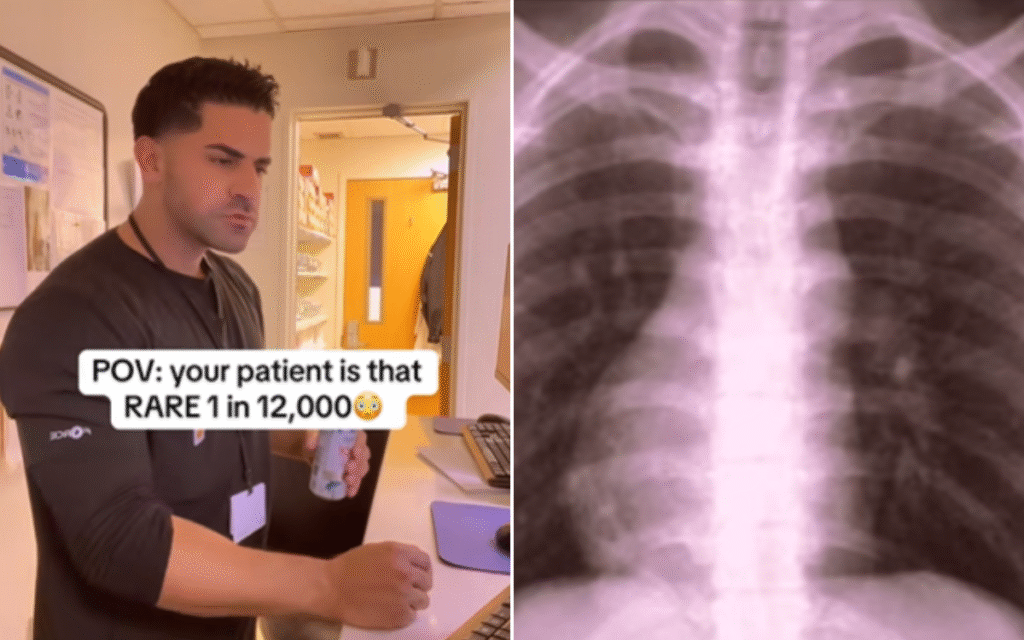A radiological technologist has described being genuinely shocked when the results of routine X-ray on one of his patients threw up something rarely seen.
Diego Diaz, who is based in New York City and specializes in MRIs and X-rays, told Newsweek what unfolded that day is a reminder that “staying proactive about your health really matters.” He said: “This was just a standard chest X-ray, but it revealed something the patient didn’t even know about.”
Previous research highlighted how a worrying number of people are avoiding important health screenings. In 2023, a survey of just over 2,000 employed U.S. adults conducted on behalf of Aflac Incorporated, a leading provider of supplemental health insurance, found 1 in 2 avoided at least one common health screening. One in 4 also admitted to skipping regular checkups because they “are feeling healthy.”
Diaz hopes that stories like the one he shared to his TikTok, @onedayyoumay, shows how “even when you feel fine, there could be things going on that only imaging can catch.”
The patient who came in for an X-ray that day had no idea what it would reveal. It certainly caught Diaz by surprise.
“When I saw it on the X-ray, I was genuinely shocked,” he said. “At first, I thought the image might have been flipped by mistake, which is something we always double-check. But once I looked at the radiology marker showing the correct side, I realized the positioning was accurate.”
What Diaz saw was a textbook case of Dextrocardia, a congenital anomaly that sees the heart develop on the right side of the chest rather than the left. This rare congenital heart condition defect occurs in around 1 out of every 12,000 births, according to Johns Hopkins Medicine.
Looking at the X-ray, Diaz was momentarily stunned at what it revealed. “It’s one of those moments that really catches your attention because it’s so rare to see in real life,” he said.
It wasn’t the first time he had encountered a case of the condition, though. “I actually encountered Dextrocardia once during my time as a student a few years ago,” he said. “There are technologists with 25 years of experience who’ve only seen it once in their entire careers, so coming across it twice already definitely stood out to me.”
In that moment, however, Diaz had to stay calm and focused on the job at hand. As much as it had been a surprise, it was crucial he not let any of that emotion show to the patient. Instead, his first task was to relay what he had seen to the radiologist.
“They might assume there was a technical error or that the image was marked incorrectly, so it’s important to communicate what we observed during the X-ray or scans,” Diaz said.
All of this had to be done while remaining outwardly neutral to the patient they were dealing with. “This patient had no idea,” Diaz added. “In moments like that, it’s important to stay composed and focused. As technologists, we’re trained to keep a neutral and professional demeanor, even when we come across something rare or unexpected.”
Though there was some “internal surprise” at what he saw, the priority was to complete the exam accurately, ensuring the patient felt comfortable throughout. Diaz channeled that experience into his TikTok video. He never includes real patients in his clip, which mostly amount to skits. But it is real stories and true experiences that drive his social media output and he makes it clear no patients are ever harmed or neglected.
“I created the video because I knew how rare and visually striking dextrocardia is. Most people have never even heard of it, let alone seen an actual X-ray showing the heart on the right side,” Diaz said. “I wanted to use that moment to educate and spark curiosity, not just among health care professionals but the general public, too.”
Though the results were unexpected, Diaz said Dextrocardia is something many live with. Some may not even know they do. “Dextrocardia on its own isn’t always a problem,” he added. “Many people live normal lives without knowing they have it. But, in some cases, it can be linked to other conditions, so it’s something that usually calls for a closer look just to be safe.”
Regardless of this, his story serves as a reminder of the need for regular checkups. You truly never know what they might find.
Read the full article here
